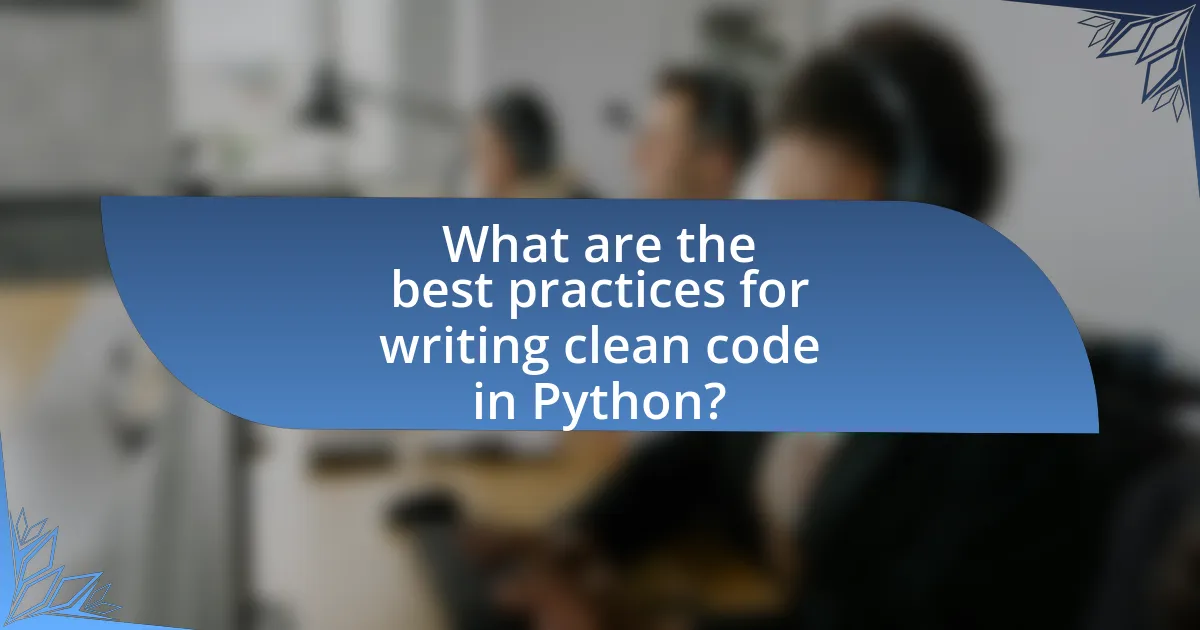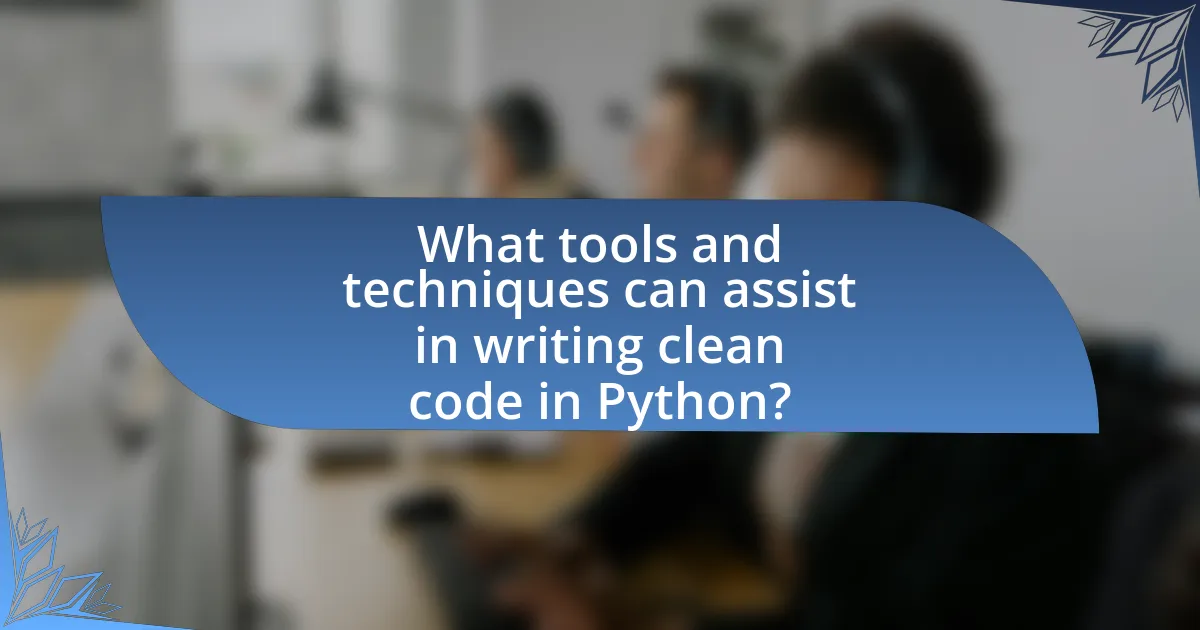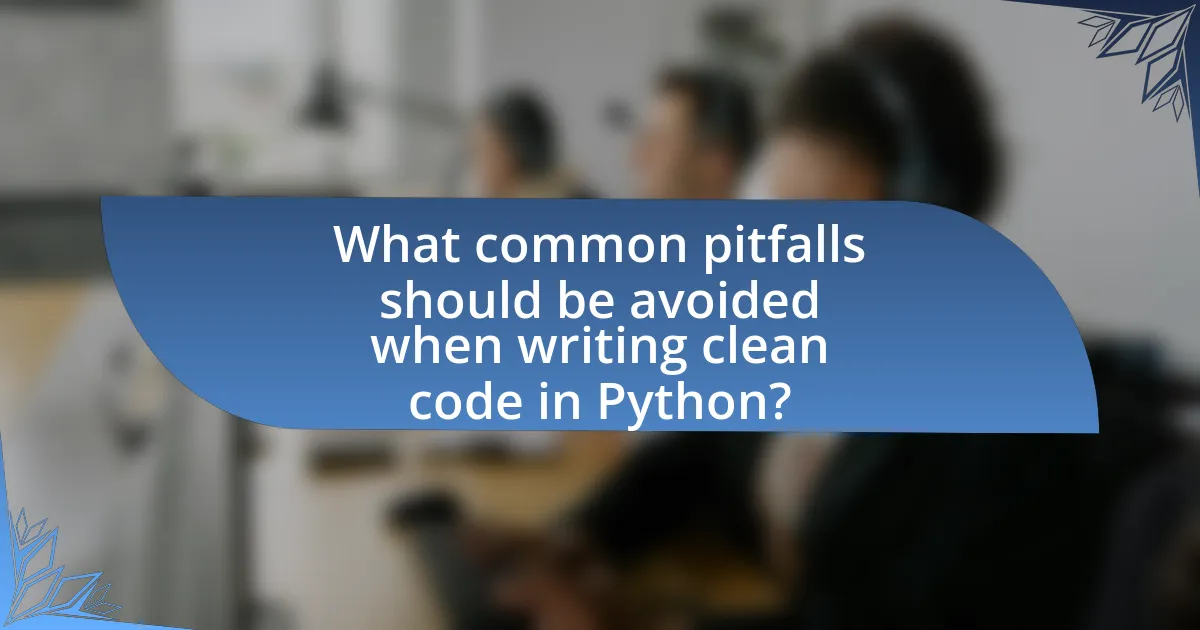The article focuses on best practices for writing clean code in Python, emphasizing the importance of readability, maintainability, and collaboration among developers. Key practices include using meaningful variable names, adhering to the PEP 8 style guide, writing modular code, and incorporating comments and documentation. The article also discusses the impact of clean code on project success, highlighting how it reduces maintenance costs and enhances team productivity. Additionally, it covers tools and techniques such as linters and automated testing that assist in maintaining code quality, while outlining common pitfalls to avoid in the coding process.

What are the best practices for writing clean code in Python?
The best practices for writing clean code in Python include using meaningful variable names, adhering to the PEP 8 style guide, writing modular code, and including comments and documentation. Meaningful variable names enhance code readability, making it easier for others to understand the purpose of each variable. The PEP 8 style guide provides conventions for formatting Python code, promoting consistency and clarity. Writing modular code through functions and classes allows for better organization and reusability, which simplifies maintenance. Additionally, including comments and documentation helps explain complex logic and provides context, facilitating easier collaboration and future modifications. These practices are supported by the Python community’s emphasis on readability and maintainability, as highlighted in the Zen of Python, which states, “Readability counts.”
Why is clean code important in Python programming?
Clean code is important in Python programming because it enhances readability and maintainability, which are crucial for collaborative development and long-term project success. Readable code allows developers to understand and modify the codebase more easily, reducing the time spent on debugging and feature implementation. According to a study by the University of Alberta, clean code practices can lead to a 40% reduction in maintenance costs, demonstrating the financial benefits of investing in code quality. Furthermore, adhering to clean code principles fosters better communication among team members, as clear and consistent coding styles facilitate knowledge transfer and onboarding of new developers.
How does clean code improve maintainability?
Clean code improves maintainability by making the codebase easier to read, understand, and modify. When code is well-structured and follows consistent naming conventions, developers can quickly grasp its functionality, reducing the time needed for onboarding new team members or revisiting old code. Studies show that clean code can reduce the cost of maintenance by up to 40%, as it minimizes the likelihood of introducing bugs during updates or enhancements. This efficiency is crucial in software development, where frequent changes are common, and maintaining high-quality code is essential for long-term project success.
What impact does clean code have on collaboration?
Clean code significantly enhances collaboration among developers by improving code readability and maintainability. When code is well-structured and follows consistent naming conventions, team members can easily understand each other’s work, reducing the time needed for onboarding and code reviews. Research indicates that teams using clean coding practices experience a 30% increase in productivity due to fewer misunderstandings and quicker problem resolution. This streamlined communication fosters a collaborative environment where developers can efficiently share knowledge and contribute to the project, ultimately leading to higher quality software outcomes.
What are the key principles of clean code in Python?
The key principles of clean code in Python include readability, simplicity, and consistency. Readability ensures that code is easy to understand, which is achieved through meaningful naming conventions and proper use of whitespace. Simplicity emphasizes writing code that is straightforward and avoids unnecessary complexity, making it easier to maintain and debug. Consistency involves adhering to established coding standards and style guides, such as PEP 8, which promotes uniformity across the codebase. These principles collectively enhance collaboration among developers and improve the overall quality of the software.
How do naming conventions contribute to clean code?
Naming conventions contribute to clean code by enhancing readability and maintainability. When developers adhere to consistent naming conventions, it becomes easier for others to understand the purpose and functionality of variables, functions, and classes at a glance. For instance, using descriptive names like “calculateTotal” instead of vague terms like “doStuff” allows for immediate comprehension of the code’s intent. Research indicates that code readability can significantly impact development speed and error rates; a study by the University of Alberta found that well-named variables can reduce the time needed to understand code by up to 50%. Thus, effective naming conventions are essential for fostering collaboration and reducing cognitive load in software development.
What role does code structure play in readability?
Code structure significantly enhances readability by organizing code logically and consistently, making it easier for developers to understand and maintain. A well-structured codebase employs clear naming conventions, consistent indentation, and modular design, which collectively facilitate quick comprehension of the code’s purpose and functionality. Research indicates that developers spend up to 80% of their time reading code rather than writing it, underscoring the importance of readability in software development. By adhering to established coding standards and practices, such as those outlined in PEP 8 for Python, developers can improve the clarity and accessibility of their code, ultimately leading to more efficient collaboration and reduced error rates.
How can comments and documentation enhance clean code?
Comments and documentation enhance clean code by providing clarity and context, making it easier for developers to understand the purpose and functionality of the code. Clear comments explain complex logic, while comprehensive documentation outlines the overall structure and usage of the code, facilitating maintenance and collaboration. Research indicates that well-documented code can reduce onboarding time for new developers by up to 50%, as they can quickly grasp the codebase’s intent and design. This reduction in ambiguity leads to fewer errors and improved code quality, reinforcing the importance of comments and documentation in maintaining clean code practices.
What types of comments are most effective in Python?
The most effective types of comments in Python are docstrings and inline comments. Docstrings provide a clear description of modules, classes, and functions, enhancing code readability and usability by serving as documentation that can be accessed through help functions. Inline comments, on the other hand, clarify complex or non-obvious code segments, helping maintainers understand the logic without needing to decipher the code itself. According to PEP 257, which outlines conventions for docstrings, these comments should be used to describe the purpose and usage of code elements, thereby improving overall code quality and maintainability.
How should documentation be structured for clarity?
Documentation should be structured with clear headings, concise language, and logical organization to enhance clarity. Clear headings allow readers to quickly identify sections, while concise language minimizes ambiguity. Logical organization, such as grouping related topics and using bullet points for lists, aids in comprehension. According to the “Writing Documentation” guidelines by the University of California, Berkeley, effective documentation should also include examples and visuals where applicable, as these elements can significantly improve understanding and retention of information.

What tools and techniques can assist in writing clean code in Python?
Tools and techniques that assist in writing clean code in Python include linters, formatters, and code review practices. Linters like Pylint and Flake8 analyze code for stylistic errors and enforce coding standards, ensuring consistency and readability. Formatters such as Black automatically format code to adhere to PEP 8 guidelines, promoting uniformity across projects. Additionally, code review practices, facilitated by platforms like GitHub, encourage collaboration and feedback, helping to identify potential issues early in the development process. These tools and techniques collectively enhance code quality, maintainability, and collaboration among developers.
What are the best linters and formatters for Python?
The best linters and formatters for Python are Flake8 and Black. Flake8 combines several tools to check for style guide enforcement, programming errors, and complexity, making it a comprehensive linter. Black is an opinionated code formatter that automatically reformats Python code to adhere to a consistent style, enhancing readability. Both tools are widely adopted in the Python community, with Flake8 being favored for its thoroughness and Black for its ability to save time on formatting decisions.
How do linters help identify code issues?
Linters help identify code issues by analyzing source code for potential errors, stylistic inconsistencies, and adherence to coding standards. They perform static code analysis, which means they evaluate the code without executing it, allowing developers to catch problems early in the development process. For instance, linters can detect syntax errors, unused variables, and code that does not conform to specified style guidelines, such as PEP 8 in Python. This proactive identification of issues enhances code quality and maintainability, ultimately leading to fewer bugs and improved collaboration among developers.
What formatting tools can enforce style guidelines?
Formatting tools that can enforce style guidelines include linters and code formatters. Linters, such as Pylint and Flake8, analyze Python code for stylistic errors and enforce adherence to PEP 8, the official style guide for Python. Code formatters like Black and autopep8 automatically reformat code to comply with style guidelines, ensuring consistency across projects. These tools are widely used in the Python community to maintain code quality and readability, which are essential for clean code practices.
How can automated testing contribute to clean code?
Automated testing contributes to clean code by ensuring that code functions as intended and remains maintainable over time. It facilitates early detection of bugs, which helps developers address issues before they escalate, thereby promoting code quality. Additionally, automated tests serve as documentation for expected behavior, making it easier for developers to understand and modify the codebase. Research indicates that teams employing automated testing practices experience a 40% reduction in bugs, leading to cleaner, more reliable code.
What types of tests are essential for Python projects?
Unit tests, integration tests, and functional tests are essential for Python projects. Unit tests verify individual components for correctness, integration tests ensure that different modules work together as intended, and functional tests validate the overall behavior of the application against requirements. According to the Python Software Foundation, unit testing is a critical practice that helps catch bugs early and facilitates code refactoring, while integration testing confirms that the system components interact correctly.
How does test-driven development promote clean code?
Test-driven development (TDD) promotes clean code by ensuring that code is written to meet specific requirements before it is implemented. This approach encourages developers to think critically about the design and functionality of their code, leading to simpler, more modular structures. By writing tests first, developers clarify the expected behavior of the code, which helps eliminate unnecessary complexity and promotes adherence to coding standards. Furthermore, TDD facilitates continuous refactoring, as the presence of tests provides a safety net that allows developers to improve code quality without fear of introducing new bugs. This iterative process ultimately results in cleaner, more maintainable code.

What common pitfalls should be avoided when writing clean code in Python?
Common pitfalls to avoid when writing clean code in Python include excessive complexity, lack of documentation, and poor naming conventions. Excessive complexity arises when code is overly intricate, making it difficult to understand and maintain; adhering to the principle of simplicity can mitigate this issue. Lack of documentation leads to confusion for future developers or even the original author, as clear comments and documentation are essential for conveying the purpose and functionality of the code. Poor naming conventions hinder readability; using descriptive and meaningful names for variables and functions enhances clarity and understanding. These pitfalls are widely recognized in software development literature, emphasizing the importance of clean code practices for maintainability and collaboration.
What are the most frequent mistakes made by Python developers?
The most frequent mistakes made by Python developers include improper use of indentation, neglecting to follow PEP 8 style guidelines, and failing to manage dependencies effectively. Improper indentation can lead to syntax errors and unexpected behavior, as Python relies on indentation to define code blocks. Neglecting PEP 8 can result in code that is difficult to read and maintain, as PEP 8 provides a standard for writing clean and consistent code. Additionally, failing to manage dependencies can lead to version conflicts and broken environments, which can hinder development and deployment processes. These mistakes are commonly observed in both novice and experienced developers, highlighting the importance of adhering to best practices in Python programming.
How can overcomplicating code lead to issues?
Overcomplicating code can lead to issues such as increased difficulty in understanding, maintaining, and debugging the code. When code is overly complex, developers may struggle to grasp its functionality, which can result in errors during modifications or enhancements. According to a study by the National Institute of Standards and Technology, poor software quality, often stemming from complex code, can cost the U.S. economy approximately $59.5 billion annually due to rework and maintenance. This highlights that complexity not only hampers individual productivity but also has broader economic implications.
What are the dangers of neglecting code reviews?
Neglecting code reviews can lead to significant risks, including increased bugs, security vulnerabilities, and reduced code quality. When code reviews are overlooked, developers may miss critical errors that could have been identified through peer examination, resulting in software that is prone to failures. A study by the National Institute of Standards and Technology found that the cost of fixing a defect after release can be up to 100 times higher than addressing it during the development phase. Additionally, without code reviews, best practices and coding standards may not be enforced, leading to inconsistent code that is harder to maintain and understand. This lack of oversight can also foster a culture of complacency, where developers may not feel accountable for their work, ultimately impacting team collaboration and project success.
How can developers ensure they maintain clean code practices?
Developers can ensure they maintain clean code practices by adhering to established coding standards and guidelines, such as PEP 8 for Python. Following these standards promotes consistency in code formatting, naming conventions, and documentation, which enhances readability and maintainability. Research indicates that code readability significantly impacts the ease of collaboration and reduces the likelihood of bugs; for instance, a study by the University of Alberta found that well-structured code can decrease debugging time by up to 50%. Additionally, regular code reviews and refactoring sessions help identify and eliminate technical debt, further supporting clean code practices.
What strategies can be implemented for continuous improvement?
Implementing strategies for continuous improvement in writing clean code in Python involves adopting practices such as code reviews, automated testing, and regular refactoring. Code reviews facilitate knowledge sharing and help identify potential issues early, as evidenced by studies showing that peer reviews can reduce defects by up to 30%. Automated testing ensures that code changes do not introduce new bugs, with research indicating that test-driven development can lead to a 40% reduction in defects. Regular refactoring allows developers to improve code structure without changing functionality, which is crucial for maintaining code quality over time. These strategies collectively enhance code maintainability and reliability, aligning with best practices in software development.
How can peer feedback enhance code quality?
Peer feedback enhances code quality by providing diverse perspectives that identify issues and suggest improvements. When developers review each other’s code, they can spot bugs, improve readability, and ensure adherence to coding standards, which collectively lead to higher quality code. Research indicates that peer code reviews can reduce defects by up to 80%, as highlighted in the study “The Impact of Peer Code Review on Software Quality” by Johnson et al. (2019). This collaborative approach fosters knowledge sharing and skill development, ultimately resulting in more maintainable and efficient code.
What practical tips can help in writing clean code in Python?
To write clean code in Python, prioritize readability, maintainability, and simplicity. Use meaningful variable and function names to convey purpose clearly, which enhances understanding for anyone reading the code. Adhere to the PEP 8 style guide, which provides conventions for formatting Python code, ensuring consistency across projects. Implement modular design by breaking code into smaller, reusable functions or classes, which simplifies testing and debugging. Additionally, include comments and documentation to explain complex logic, making it easier for others to follow. Regularly refactor code to improve structure without changing functionality, which helps eliminate redundancy and enhances clarity. These practices collectively contribute to writing clean, efficient, and understandable Python code.
How can developers create a personal checklist for clean coding?
Developers can create a personal checklist for clean coding by identifying key principles of clean code and translating them into actionable items. This checklist should include items such as ensuring meaningful variable names, maintaining consistent indentation, writing modular functions, and including comments where necessary to explain complex logic. Research indicates that following these principles can significantly enhance code readability and maintainability, as highlighted in “Clean Code: A Handbook of Agile Software Craftsmanship” by Robert C. Martin, which emphasizes the importance of clarity and simplicity in coding practices. By regularly reviewing and updating this checklist, developers can foster a habit of writing clean code consistently.
What resources are available for learning more about clean code in Python?
Books such as “Clean Code: A Handbook of Agile Software Craftsmanship” by Robert C. Martin and “Python Clean Code” by Mariano Anaya provide foundational knowledge on clean coding practices. Online platforms like Coursera and Udemy offer courses specifically focused on clean code principles in Python, often featuring hands-on projects. Additionally, the official Python documentation includes guidelines on writing clean and efficient code, reinforcing best practices. These resources collectively equip learners with the necessary skills to write clean code in Python effectively.


